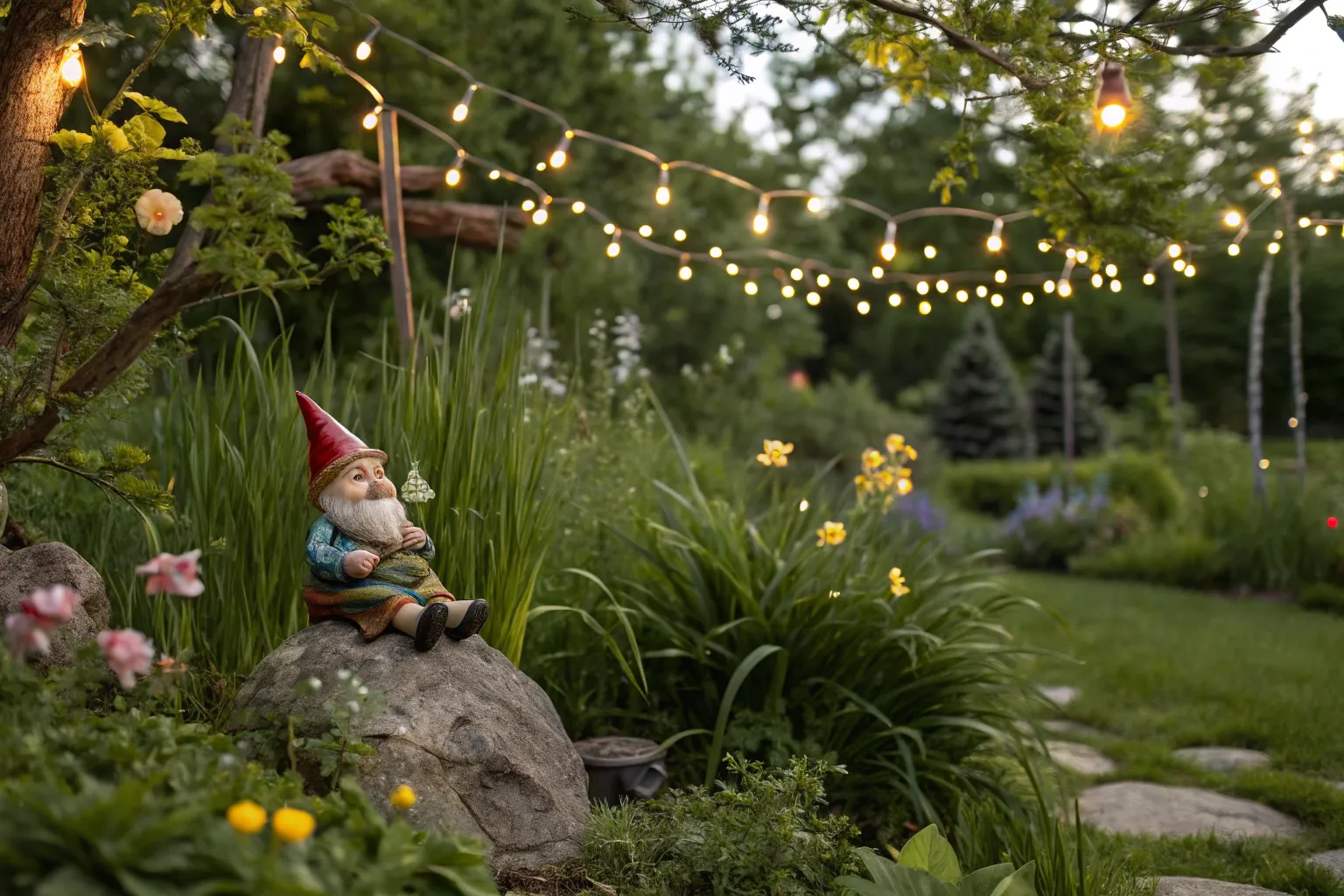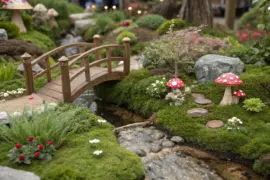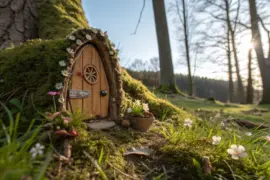Picture yourself kneeling beside a gnarled oak tree, tucking a pinecone-shingled roof onto a tiny home built between its roots. That’s where the magic begins.
Who Are Gnomes?

Gnomes have wandered through folklore for centuries, appearing in tales across Europe as earth-dwelling spirits who move through soil as easily as we walk upon it. These diminutive guardians of the natural world are typically imagined as small, bearded figures wearing pointed hats, protecting forests, tending gardens, and guarding treasures hidden deep underground. In Scandinavian tradition, they’re known as tomte or nisse—household protectors who watch over farms and families with quiet devotion.
What makes gnomes such wonderful subjects for crafting and storytelling is their connection to nature. They’re believed to communicate with animals, understand the secrets of plants, and possess ancient wisdom about the earth itself. When you create a gnome world, you’re building a bridge between the everyday and the enchanted.
Gathering Your Materials

The beauty of gnome crafting lies in what you can find right outside your door. A walk through woods or garden becomes a treasure hunt when you’re collecting materials for miniature worlds.
Natural Elements to Collect:
- Moss in different textures—reindeer moss for fluffy tree canopies, sheet moss for ground cover
- Pinecones of varying sizes for roofs, decorative accents, or tiny woodland creatures
- Twigs and small branches for walls, ladders, and bridges
- Smooth pebbles and small stones for pathways, walls, or rooftops
- Acorns, bark pieces, leaves, and seed pods for detailing
Craft Supplies Worth Having:
- Terra cotta pots in various sizes (these become homes when flipped upside down)
- Cardboard, paper plates, or milk cartons for building bases
- Hot glue gun and glue sticks (or white craft glue for younger children)
- Brown acrylic paint for adding bark texture to structures
- Preserved moss if you can’t forage fresh
- Small wooden pieces, craft sticks, or popsicle sticks
Building Gnome Homes

Creating a gnome dwelling is about capturing that tucked-away feeling—like discovering something secret and special.
The Terra Cotta Pot Method
This approach gives you a sturdy structure quickly. Paint a clay pot with brown acrylics, adding vertical streaks and darker lines to mimic tree bark. Once dry, flip the pot upside down. The drainage hole becomes a perfect chimney opening. Cover the “roof” (now the bottom of the pot) with layers of moss, working from darker green sheet moss at the base up to lighter, fluffier reindeer moss at the top. Arrange small stones in overlapping patterns like roof tiles, securing each with hot glue.
Add a miniature door cut from cardboard or purchased as a fairy garden accessory. Position it against the pot’s side, perhaps nestled between two larger stones that become doorposts. A tiny ladder made from twigs and hot glue can lean against the house, inviting exploration.
The Natural Build Method
For a more organic approach, use a cardboard base or wooden round as your foundation. Build walls by gluing vertical twigs side by side, or stack small stones with dabs of glue between them. Pinecone scales pulled apart individually make excellent roofing shingles with a realistic overlapping texture.
Create window openings by cutting squares in your cardboard base before construction begins, or leave gaps between twigs. A piece of clear plastic or acetate behind the opening suggests glass catching light. For a cozy glow effect, tuck a battery-operated tea light inside before sealing everything up.
Textured Walls and Realistic Details
The difference between a craft project and something magical often comes down to texture. When working with cardboard or plain surfaces, spread a thin layer of joint compound or air-dry clay and press natural materials into it—bark fragments, small pebbles, or even the texture from a piece of fabric. This builds dimension that catches light beautifully.
Tiny bundles of twigs tied with natural jute twine become firewood stacks beside the door. Flat wooden rounds serve as stepping stones leading to the entrance. A miniature wooden sign (easily made from a popsicle stick and permanent marker) announces the gnome resident’s name.
Creating Gnome Village Scenes

A single home is enchanting, but a village tells a story.
Laying Out Your Scene
Choose a base that suits your space—a wooden tray, large ceramic saucer, or shallow basket all work beautifully. For outdoor gnome villages, you might select a spot at the base of a tree or in a garden bed where the scene can nestle into existing plants.
Think about pathways connecting different dwellings. Small pebbles pressed into soil or moss create walking paths. Birch rounds (thin slices of small branches) make wonderful stepping stones with their natural rings visible on the surface.
Building Vertical Interest
Real landscapes have different heights, and miniature ones should too. Stack small stones to create retaining walls or elevated garden beds. Use wood slices of varying thickness to create platforms at different levels. A thicker piece of bark propped at an angle becomes a hillside, especially convincing when partially covered with moss.
A simple bridge made from a cardboard tube cut lengthwise, covered with glued-on twigs, and supported by stone “pylons” on each end adds wonderful dimension. Position it over a “stream” of blue glass beads or painted stones.
Lighting for Atmosphere
Lighting transforms a miniature scene from cute to captivating. Battery-operated fairy lights with tiny LED bulbs can be woven through moss or tucked into structures to create warm glows. Solar-powered garden lights miniaturized for fairy gardens work beautifully in outdoor scenes, automatically illuminating at dusk.
For photography or evening enjoyment, position a small lamp or flashlight at different angles around your scene. Light from below creates drama—imagine firelight flickering from a miniature campfire circle made of tiny stones. Side lighting emphasizes texture, making moss look lush and stones appear more dimensional.
Making Miniature Gnome Characters

While purchased figurines work perfectly, creating your own gnomes adds personal magic.
Simple Craft Stick Gnomes
Paint the pointed end of a wooden craft stick (the paddle-shaped ones work best) in red or blue for a hat. Paint the wider bottom section in a complementary color for the body, leaving a small unpainted section between for the face. Once dry, add a beard using dimensional paint, white felt, or even cotton pulled into a wispy shape. Draw simple facial features with a fine-tip permanent marker—two dots for eyes peeking out from under the hat brim.
These delightful gnomes can be planted in pots or garden soil as whimsical markers.
Air-Dry Clay Characters
For dimensional gnomes, air-dry clay is wonderfully forgiving. Roll a cone shape for the body and a smaller cone for the hat. Press them together, smoothing the seam. Roll a tiny ball for the nose and press it onto the face area. Once dry (usually 24 hours), paint with acrylics. Add a beard cut from faux fur scraps, felt, or even natural fibers like cotton or wool.
Keep proportions exaggerated—large hats, prominent noses, and generous beards capture that classic gnome character.
Personality Through Details
Give each gnome individual personality. One might carry a tiny basket (woven from raffia or made from a small nut shell). Another could hold a miniature shovel (a toothpick with a flattened piece of clay or cardboard attached). A third might be “reading” a book made from folded paper. These small details invite storytelling.
Furnishing the Gnome World
The objects that populate a gnome scene bring it to life.
Miniature Furniture and Accessories
A table and chairs can be fashioned from twigs hot-glued together, with larger wood slices serving as tabletops. Tiny terracotta pots become planters filled with moss or the smallest faux succulents. An acorn cap makes a perfect bowl or drinking vessel.
Create a clothesline by stretching twine between two twig posts and hanging tiny fabric scraps cut into clothing shapes. A miniature broom is simply a twig with raffia or dried grass tied to one end.
Garden Elements
Gnomes are gardeners at heart. Create tiny raised beds from stacked flat stones or twigs glued into rectangles. Fill these with different colors of moss to suggest various plantings. Press tiny dried flowers into the moss. Faux succulents sized for terrariums work beautifully and add varied shapes and colors.
A miniature wheelbarrow (available in fairy garden sections or easily made from a small shell and twig wheels) filled with tiny pinecones or pebbles suggests ongoing work.
Natural Accents
Small pinecones become trees when “planted” upright in clay or glued to wooden bases. Clusters of three create a forest grove. Acorns scattered around the scene look like provisions being gathered. A small flat rock becomes a bench, a larger one with a depression might be a birdbath.
Dried flowers—especially tiny blooms like baby’s breath or small sections of larger dried flowers—add color without overwhelming the scale.
Story Starters for Gnome Adventures
Crafting the physical world is only half the magic. Stories bring gnomes fully to life.
The Night Watch
Your gnome is responsible for watching over the garden through the night. What unusual visitor arrives? Perhaps the vegetables come alive and throw a party. Maybe a lost woodland creature needs help finding its way home, or the stars begin falling like raindrops and must be caught and returned to the sky. Let the problem escalate before your gnome discovers a creative solution.
Seasonal Celebrations
Gnomes mark the changing seasons with special traditions. In autumn, they might prepare for the Lantern Walk, crafting tiny lanterns from acorn caps and firefly light. During spring, they wake sleeping seeds and paint the first flowers. Summer brings the Midsummer Moss Festival, while winter means cozy storytelling around miniature fires.
The Lost Treasure
Legend says gnomes guard underground treasures. Your gnome discovers a map, receives a mysterious visitor, or notices something unusual that leads to an adventure. Perhaps the treasure isn’t gold, but something more valuable—the seed of a rare plant, a key that unlocks kindness, or a stone that reveals hidden truths when held.
Community Helpers
Scandinavian tradition portrays gnomes as helpers who perform small acts of kindness. Create stories where your gnome secretly aids garden creatures—mending a bird’s nest, building a shelter for a mouse family, or creating a bridge so ants can cross a stream. Introduce a challenge that requires cooperation from all the garden inhabitants.
The Four Seasons House
Imagine a gnome whose home magically changes with each season. In spring, the roof blooms with flowers. Summer brings vines and butterflies. Autumn covers everything in colorful leaves, and winter frosts the roof with snow. Tell the story of how the gnome prepares for each transformation, or what happens when the seasons get confused.
Bringing Stories and Crafts Together
The most memorable experiences happen when making and storytelling intertwine.
Build as You Tell
Narrate a simple gnome story while children build elements from it. “The gnome needed a bridge to cross the stream, so he gathered three strong sticks…” Pause while they create that bridge. “On the other side grew a magical tree…” Let them construct it. This active storytelling keeps hands and imaginations equally busy.
Story Stone Prompts
Paint or draw simple images on smooth stones—a gnome, a door, a tree, a star, an acorn. Place them face-down. Draw three stones randomly and create a story incorporating all three images. These visual prompts spark ideas when storytelling feels stuck.
Character Diaries
Once you’ve created a gnome character, write diary entries from their perspective. What did they see today? What worried them? What made them laugh? Even a few sentences brings remarkable personality to your creation.
Village Voice Conversations
If you’ve built multiple gnome homes, give each resident a distinct personality and voice. Act out conversations between neighbors. Perhaps one gnome grows the best mushrooms and shares gardening advice. Another might be forgetful and constantly misplacing their tiny tools. These character quirks create natural story conflicts and resolutions.
Finishing With a Touch of Magic
The final details are where your gnome world becomes truly yours.
Weathering and Age
Nothing in nature stays pristine. Lightly dry-brush white or light gray paint over moss-covered roofs to suggest morning frost or age. A wash of brown or green watered-down acrylic paint over stones and wood adds depth and makes everything look like it’s been there forever. Dust a tiny amount of cinnamon around the base of structures for an earthy, forest-floor appearance.
The Photographer’s Eye
Get down to gnome-eye level. What you see from that perspective reveals whether your scene works at its intended scale. Photograph from this low angle to share your creation or simply to appreciate details you might miss from above. Early morning or late afternoon light adds drama and warmth to miniature scenes.
The Invitation to Wonder
Leave something slightly mysterious. A tiny door left ajar. A miniature letter rolled and tied with thread. A single acorn placed deliberately on a stone. These unresolved elements invite viewers to complete the story themselves, which is perhaps the greatest gift any creation can offer.
Gnome worlds grow and change over time. A moss roof eventually needs refreshing. Seasons call for different decorations. New stories emerge with each element you add. That’s the beautiful secret—there’s no final version, only the next chapter waiting to be imagined and built.





